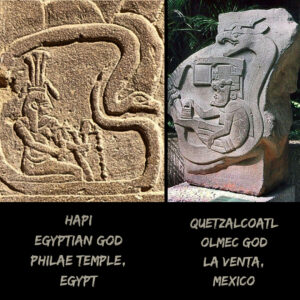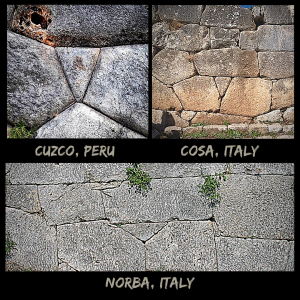
The Olmec – Egyptian Connection
The visual representation of the gods Hapi and Quetzalcoatl is just the tip of the iceberg of the many connections between the Olmec and the Egyptian cultures.

The visual representation of the gods Hapi and Quetzalcoatl is just the tip of the iceberg of the many connections between the Olmec and the Egyptian cultures.

The V pattern gives these ancient walls anti-seismic properties. Yet another technique shared by the megalithic builders all over the Earth.

Anti-seismic megalithic from a bygone age are still visibile scattered throughout the Earth as they were engineered to stand the tests of time.
The Younger Dryas impact theory suggests that a comet or asteroid impact caused a sudden cooling event around 12,900 years ago, marking the transition from the warm Allerød period to the colder Younger Dryas period. This event is thought to have significantly affected climate and ecosystems, leading to widespread extinctions of megafauna and impacting human populations.
Proponents of the theory point to evidence such as a layer of iridium-rich sediment found in various locations, suggesting an extraterrestrial impact. Other indicators include signs of fire and changes in flora and fauna, which align with a rapid temperature drop. However, this theory is still debated, with some researchers arguing that other factors, such as changes in ocean currents or volcanic activity, could also explain the climate shift. Overall, while the theory has gained some traction, it remains a topic of active research and discussion in the scientific community.
Although the impact itself is still debated, major changes in the environment of the Earth certainly occurred, and led to the mass extinction of megaflora and megafauna. If there were any culture and civilizations already thriving at that time, these events certainly led to their extinction, too.
Whether caused by a comet impact or by sudden climate changes, the Younger Dryas event triggered mass extinctions all over the Earth. Several ancient legends, religions, mythologies, and historians, report that a thriving civilization occupied the Earth before its disappearance.
According to many ancient historians, who reconstructed past events relying on oral traditions and older documents, like Thucydides, Plato, Syncellus, Diodorus, Herodotus, Josephus, Strabo, and several others, the civlization that inhabited the Earth before the natural catastrophe built the megalithic sites in Greece, Italy, and Egypt, using techniques unknown to them and still partially unknown to us.
The more we research ancient cultures, the more we find that they shared similarities with each others. In particular, the oldest known civilizations from every continent shared the most similarities. With the passing of time, it seems that many cultures lost those similarities and evolved in their own paradigm.
The megalithic builders used identical processes to carve, cut, and put multi-ton blocks into place all over the earth, resulting in a very similar outlook to the naked eye. For example, the so called “scoop marks” on the surface of the blocks are clearly visible at Macchu Picchu, the Giza Plateu, Stonehenge, Ollantaytambo, Japan, the Aswan Quarry and many other places.
Same thing goes for the “nubs” and the the way of stacking blocks together by “melting” them together in a way that a pin can’t fit in between. Another common thing regarding megalithic buildings is that, often, the multi-ton blocks came from hundreds or even thousands of miles away.
We still haven’t figured out how they were able to obtain these outcomes, but it is clear that they were the result of specific processes that were used in different and very distant parts of the earth in a period of time when those cultures allegedly couldn’t make contact with each other. Other striking common elements also include beliefs, traditions, and mythologies, as well as the physical depictions of their gods and their attributes, whether they are drawings or sculptures.
There is more than one theory that has been proposed over the years by different scholars and researchers.
One of the most plausible and logical one comes directly from ancient sources. Some of the ancient historians, like Strabo, Manetho, Josephus, and Plato (even though he was a philospher and not an historian), wrote in their accounts that a civilization responsible for the construction of the megalithic sites and most of the mythologies and religions prospered on earth before a worldwide natural catastrophe occured (which we currently know, thanks to science, was triggered by the Younger Dryas events).
Two possibilities stem from this theory:
1) Plato wrote in his Critia that when the natural catastrophe occurred this civilization sailed from its original place, which he calls Atlantis, and ended up in different places on earth, bringing its construction techniques, mythologies, and traditions in those places, particularly to the East and to the West. This would explain why South America and Egypt share the most similarities in both megalithic buildings and beliefs.
2) This possibility does not come from actual historical accounts, but it has been speculated by several researchers, and it implies that this civilization was able to travel long distances by the sea, eventually bringing its knowledge and traditions in many places all over the earth. This could explain several ancient myths, like the South American ones, describing people with white skin and long white hair coming from the sea and teaching them about agriculture, farming, and religion, before disappearing by sailing out at sea again.